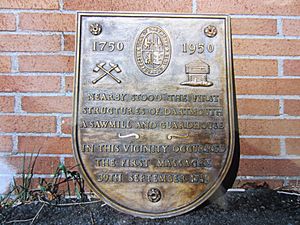Raid on Dartmouth (1749) facts for kids
Quick facts for kids Raid on Dartmouth (1749) |
|||||||
|---|---|---|---|---|---|---|---|
| Part of Father Le Loutre's War | |||||||
 Plaque to Raid on Dartmouth (1749) and the blockhouse that was built in response (1750), Dartmouth Heritage Museum |
|||||||
|
|||||||
| Belligerents | |||||||
| Mi'kmaw militia Acadian militia |
|||||||
| Commanders and leaders | |||||||
| Major Ezekiel Gilman | |||||||
| Strength | |||||||
| 40 Mi'kmaq | 6 British | ||||||
| Casualties and losses | |||||||
| 3 killed | 4 killed, 2 wounded | ||||||
The Raid on Dartmouth (1749) was an attack that happened during Father Le Loutre's War. On September 30, 1749, a group of about 40 Mi'kmaq warriors from the Chignecto area attacked a sawmill in what is now Dartmouth, Nova Scotia. The sawmill was run by Major Ezekiel Gilman. During the attack, four workers were killed and two were hurt. This raid was one of seven attacks the Wabanaki Confederacy and Acadians made on the new British settlements during the war.
Why the Raid Happened
Even though the British had taken control of Acadia (which is now Nova Scotia) in 1710, most people living there were still Catholic Acadians and Mi'kmaq. Father Le Loutre's War started when Edward Cornwallis arrived in Nova Scotia. He came with 13 ships on June 21, 1749, to build a new British settlement called Halifax.
The Mi'kmaq and other groups in the Wabanaki Confederacy had a long history of fighting with British settlers. They often fought along the border between New England and Acadia. When Governor Cornwallis arrived, he knew he needed to make peace with the Native peoples. This was important before the British could build more settlements.
On August 15, 1749, Governor Cornwallis met with leaders from several Native tribes in Halifax Harbour. They talked about signing a new peace treaty. However, around the same time, two British ships were attacked near Canso. Three British people and seven Native people were killed. The British believed a French priest, Abbe Le Loutre, was encouraging these attacks.
Abbe Le Loutre had written to a French official, saying he wanted to encourage the Native people to keep fighting the British. He hoped to make it seem like the Native people were acting on their own.
To protect the new British settlements from attacks, the British built forts. These forts were built in Halifax (1749), Bedford (1749), Dartmouth (1750), Lunenburg (1753), and Lawrencetown (1754).
On September 24, 1749, the Mi'kmaq sent a letter to Governor Cornwallis. They stated that the land belonged to them and they did not want the British settling in Halifax. Some historians believe this letter was a declaration of war. Others are not so sure.
The attacks on British settlements began in Canso, then Chignecto, and then Dartmouth. Dartmouth faced four raids during Father Le Loutre's War. Major Ezekiel Gilman was in charge of the sawmill in Dartmouth. He was a skilled lumberman and had helped the British during the Siege of Louisbourg (1745).
The Attack on Dartmouth
On September 30, 1749, about forty Mi'kmaq warriors attacked six British men. These men were cutting trees in Dartmouth. Four of the British men were killed right away. One was taken prisoner, and one managed to escape. The attack happened at the sawmill located in Dartmouth Cove. After the attack, a group of British rangers went after the Mi'kmaq. They killed two Mi'kmaq warriors.
After the Raid
After the raid, on October 2, 1749, Governor Edward Cornwallis issued a special order. This order told all British officers and subjects to "annoy, distress, take or destroy the Savage commonly called Micmac, wherever they are found." He also offered a reward for capturing or killing Mi'kmaq people, including men, women, and children. British rangers searched the area around Halifax for Mi'kmaq, but they did not find any.
Cornwallis also placed thirty soldiers to guard the sawmill through the winter. He also had two armed ships nearby. Major Gilman left Dartmouth without telling anyone by April 1750. By July, Cornwallis had given the sawmill to another person to manage.
Even with these efforts, attacks continued. In July 1750, the Mi'kmaq killed seven more men working in Dartmouth. In August 1750, 353 new settlers arrived and started building the town of Dartmouth. On September 30, 1750, Dartmouth was attacked again, and five more residents were killed. In October 1750, a group of eight men went hunting and were captured by the Mi'kmaq.
In March 1751, there were two more attacks, making it six raids in two years. Three months later, on May 13, 1751, a leader named Broussard led sixty Mi'kmaq and Acadians in another attack on Dartmouth. This attack became known as the "Dartmouth Massacre".
See also
- List of massacres in Canada


